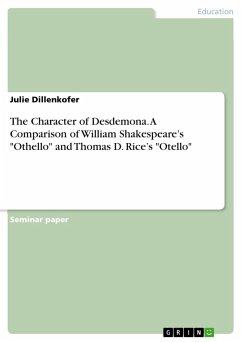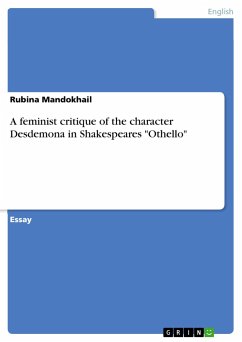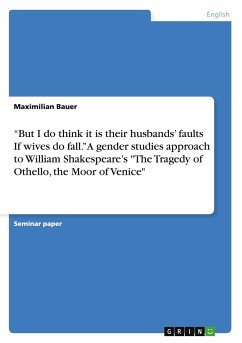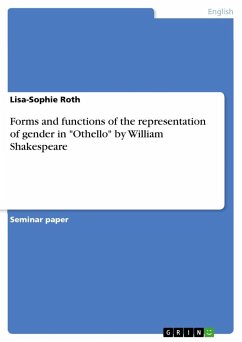Seminar paper from the year 2015 in the subject Didactics - English - Literature, Works, grade: 2,3, University of Heidelberg (Anglistisches Seminar), course: The First Century of US-American Drama, language: English, abstract: In this paper, I will compare the character of Desdemona in the play "Othello" by Shakespeare with that in the burlesque opera "Otello" by Rice. I will first analyze the figure of Desdemona in Shakespeare's play and then in Rice's opera - one after another. Next, I will compare the two characters of Desdemona and will explore in which ways their qualities coin-cide, or rather, in what extent they differ in their personalities. Lastly, I will briefly summarize the different characters of Desdemona in both "Othello" and "Otello". William Shakespeare's "Othello" portrays the mixed-race love between Desdemona, a white Venetian beauty, and the Moor Othello, Venice's general. Mislead by Iago, his ensign and also the play's villain, Othello develops an unfounded suspicion of his wife Desdemona and his lieu-tenant Cassio, which results not only in Othello's suicide, but also in the murder of his wife who, as it turns out, has been innocent of adultery all along. The tragedy thus represents love and good on the one hand (embodied by Desdemona) and the involved problem of jealousy and revenge (personified by Othello) - not least the issue of miscegenation - on the other hand. As many of Shakespeare's works (which usually are adaptations themselves), "Othello", first performed in 1606, has been the basis for numerous subsequent adaptations, such as the burlesque opera by Thomas D. Rice of 1844. The opera's plot is essentially similar to that of the play by Shakespeare, yet a few changes have been made. In Rice's parody, Otello and Desdemona have a child and Shakespeare's handkerchief has become a common towel. Yet the most conspicuous alteration is Desdemona's resurrection after being killed at the end of the play. Apart from that, it appearsthat the two characters of Desdemona in both "Othello" and "Otello" are quite alike. Depicted as a rather subordinate role in both the play and the opera, as compared to her husband and the title character Othello/Otello, Desdemona actually portrays the heroine in both stories. Both become victims of their husbands' jealousy and finally have to die despite being innocent. When taking a closer look, however, it becomes apparent that the two characters are not that comparable in their personality as initially seems to be the case. In fact, they both gradually reveal themselves as rather different people.
Hinweis: Dieser Artikel kann nur an eine deutsche Lieferadresse ausgeliefert werden.
Hinweis: Dieser Artikel kann nur an eine deutsche Lieferadresse ausgeliefert werden.








